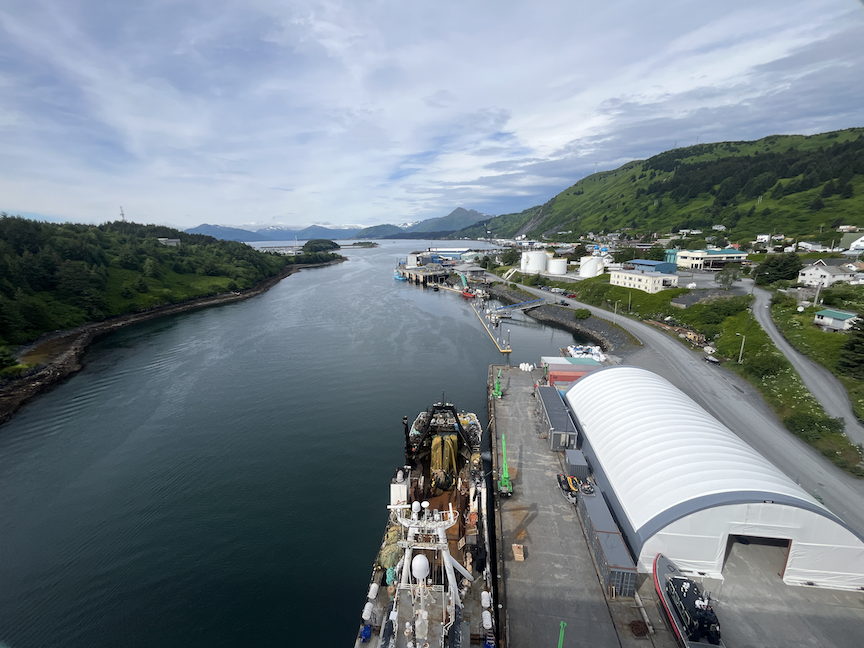A trawl vessel sits at the dock in Kodiak this summer. (Photo by Nathaniel Herz/Northern Journal)
Federal managers shut down a major Alaska fishery Wednesday after two Kodiak-based boats targeting whitefish caught some 2,000 king salmon — an unintentional harvest that drew near-instant condemnation from advocates who want better protections for the struggling species.
The Kodiak-based trawl fleet has caught just over one-fourth of its seasonal quota of pollock — a whitefish that’s typically processed into items like fish sticks, fish pies and surimi, the paste used to make fake crab.
But about 20 boats will now be forced to end their season weeks before its Nov. 1 closure, with hundreds of jobs at shore-based processing plants also in jeopardy, to make sure the fleet doesn’t exceed its yearly cap on its unintentional king salmon harvest — some 18,000 fish.
“From a community perspective, it’s huge,” said Julie Bonney, who runs a trade group, the Alaska Groundfish Data Bank, that represents the trawlers and processing companies. “Nobody’s happy about the closure, but they understand the reason.”
The incident is sure to draw more scrutiny on the issue of bycatch — the industry term for the unintended harvest, typically of salmon or halibut, by boats targeting other species.
Tribal advocates and conservation groups, for the past several years, have been making increasingly urgent pleas to managers to crack down on bycatch by trawl vessels, which can scoop up salmon in the nets they drag through the water targeting pollock and other lower-value species.
Those groups’ focus has largely been on bycatch by pollock trawlers in the Bering Sea.
The salmon caught Sunday were harvested using the same type of nets used by trawlers in the Bering Sea, but in a different area of the ocean, the central Gulf of Alaska.
Most of the salmon caught as bycatch in the gulf are from British Columbia and the U.S. West Coast, according to genetic data published by federal scientists.
But some also come from neighboring Alaska rivers, particularly in Southeast Alaska but also in small proportions from the Copper and Kenai rivers.
King salmon in many of those Alaska rivers have struggled in recent years — forcing closures and restrictions on other fishermen, and even a petition to list Gulf of Alaska kings as endangered.
The two Kodiak trawlers caught the salmon Sunday. Bonney and federal managers declined to identify the two vessels, but a co-owner of one of them, the Evie Grace, confirmed that it had harvested more than 1,200 kings in an event he called a “lightning strike.”
Up to that point in the season, the most king salmon that the Evie Grace had caught in a single trip was 53, and its total harvested over 11 trips was 270, said Kent Helligso, 69. The vessel is owned by a Kodiak-based family partnership, with some of Helligso’s grandchildren working as his family’s fifth generation in the industry, he said.
“Weather was coming up, and they set and made a tow out and yeah — probably towed way too long, we definitely know that now,” he said. “But it was just kind of unlucky, luck of the draw.”
Bycatch in the central Gulf trawl fishery is managed under a complex federal framework in which only a portion of vessels have their salmon bycatch numbers independently verified.
Because both of the two vessels involved in Sunday’s incident had their counts verified, their numbers were extrapolated out to the unverified vessels, putting the whole fleet over its annual limit of 18,316 fish, said Josh Keaton, a top federal manager with the National Marine Fisheries Service.
That’s the first time the annual cap has been hit since it went into place in 2012, said Bonney.
The formal closure wasn’t issued until Wednesday morning, but the fleet stopped fishing in the meantime, knowing the cap was at risk of being exceeded, Keaton added.
“I do think it’s important to recognize that the fleet voluntarily stood down,” he said. “They care as much about these data as we did.”
Data from processing companies that covers the trawlers’ entire harvest, which hasn’t been independently verified, shows that the fleet’s total king salmon bycatch for the season is still under 13,000, according to Helligso.
But federal managers rely only on the verified data for their closure decision, according to Keaton of the National Marine Fisheries Service.
Next year, he added, new federal rules involving onboard video cameras should result in a much larger fraction of the fleet having its catch numbers independently verified.
Each of the salmon caught by the two vessels has also been genetically sampled, Keaton said.
The data that comes back could provide some new information to managers, he added — shedding light on whether the kings mixing with a single school of pollock come from a single population, or multiple areas.
In the meantime, fishermen and processing companies are still trying to sort out whether the Kodiak trawl fleet could move to other fisheries.
But amid an economic crisis in Alaska’s seafood industry, it’s not clear that fishing for other available species, like rockfish, will pencil out, said Bonney.
“I have a feeling there’s going to be some pretty hurting checkbooks here shortly,” she said.
Nathaniel Herz welcomes tips at natherz@gmail.com or (907) 793-0312. This article was originally published in Northern Journal, a newsletter from Herz. Subscribe at this link.
GET THE MORNING HEADLINES DELIVERED TO YOUR INBOX

